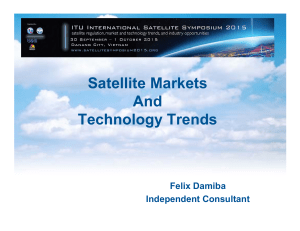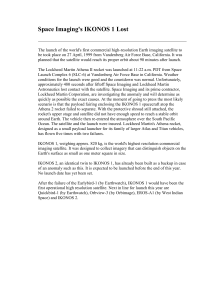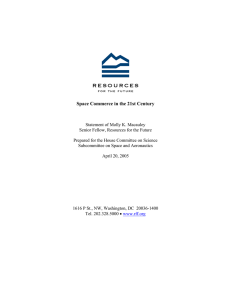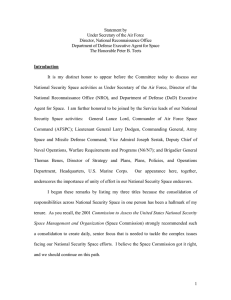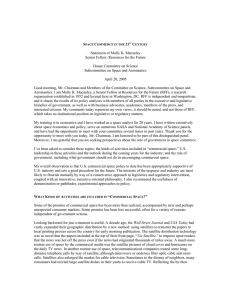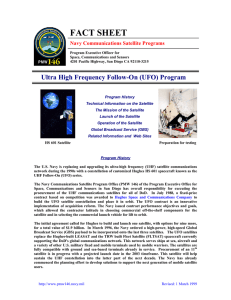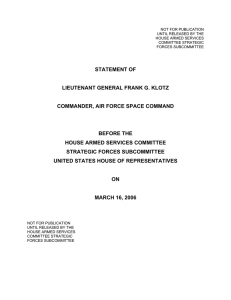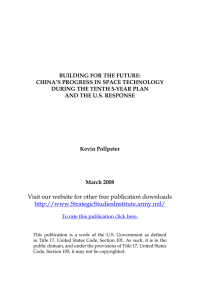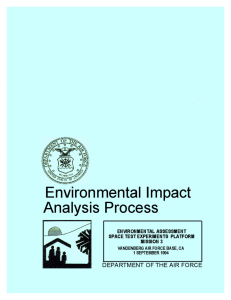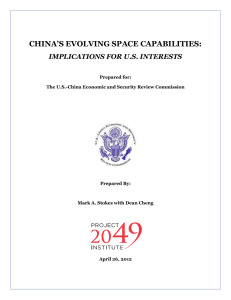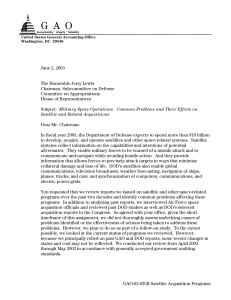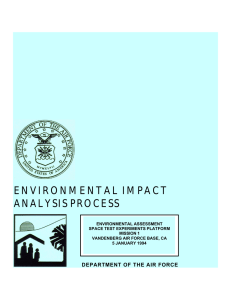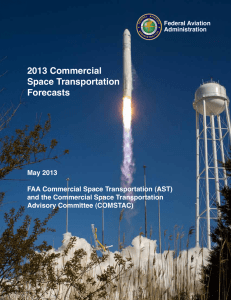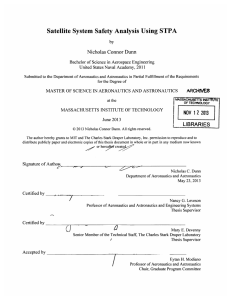THE FUTURE MARKETS FOR COMMERCIAL SPACE John W. Vinter’s Testimony
advertisement
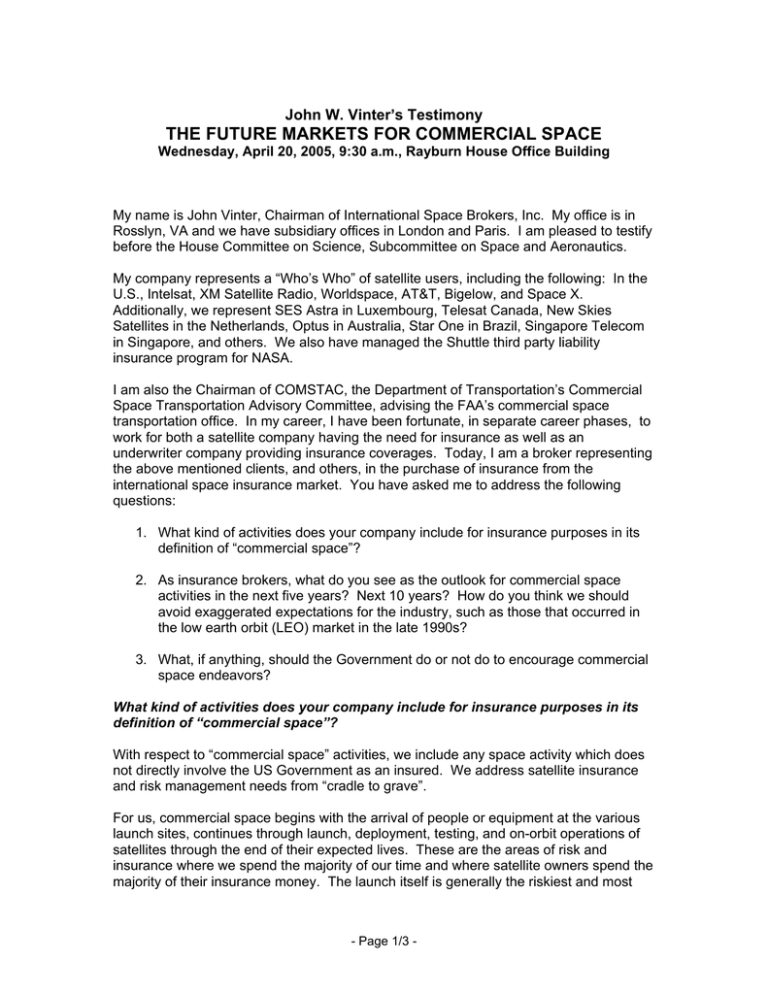
John W. Vinter’s Testimony THE FUTURE MARKETS FOR COMMERCIAL SPACE Wednesday, April 20, 2005, 9:30 a.m., Rayburn House Office Building My name is John Vinter, Chairman of International Space Brokers, Inc. My office is in Rosslyn, VA and we have subsidiary offices in London and Paris. I am pleased to testify before the House Committee on Science, Subcommittee on Space and Aeronautics. My company represents a “Who’s Who” of satellite users, including the following: In the U.S., Intelsat, XM Satellite Radio, Worldspace, AT&T, Bigelow, and Space X. Additionally, we represent SES Astra in Luxembourg, Telesat Canada, New Skies Satellites in the Netherlands, Optus in Australia, Star One in Brazil, Singapore Telecom in Singapore, and others. We also have managed the Shuttle third party liability insurance program for NASA. I am also the Chairman of COMSTAC, the Department of Transportation’s Commercial Space Transportation Advisory Committee, advising the FAA’s commercial space transportation office. In my career, I have been fortunate, in separate career phases, to work for both a satellite company having the need for insurance as well as an underwriter company providing insurance coverages. Today, I am a broker representing the above mentioned clients, and others, in the purchase of insurance from the international space insurance market. You have asked me to address the following questions: 1. What kind of activities does your company include for insurance purposes in its definition of “commercial space”? 2. As insurance brokers, what do you see as the outlook for commercial space activities in the next five years? Next 10 years? How do you think we should avoid exaggerated expectations for the industry, such as those that occurred in the low earth orbit (LEO) market in the late 1990s? 3. What, if anything, should the Government do or not do to encourage commercial space endeavors? What kind of activities does your company include for insurance purposes in its definition of “commercial space”? With respect to “commercial space” activities, we include any space activity which does not directly involve the US Government as an insured. We address satellite insurance and risk management needs from “cradle to grave”. For us, commercial space begins with the arrival of people or equipment at the various launch sites, continues through launch, deployment, testing, and on-orbit operations of satellites through the end of their expected lives. These are the areas of risk and insurance where we spend the majority of our time and where satellite owners spend the majority of their insurance money. The launch itself is generally the riskiest and most - Page 1/3 - expensive phase of any commercial space endeavor to insure. In simple terms, our objective is to cover risks of loss or damage to the satellites, including failure of the launchers, or failure of the satellite to work according to its specifications. We also provide liability coverage for damages to third parties caused by launch related and satellite operational accidents. Again, commercial space insurance coverage begins with the start of launch site activities and continues through on-orbit operations. As with the satellite coverage above, activities prior to arrival at the launch site are best covered in non-space insurance markets. We also ensure persons, for example, the lives of various astronauts and tourists/visitors to the space station, including individuals who fly or have flown on the Shuttle. From time to time, we also insure contingencies such as acts of Government, and other causes, that could affect the ability to launch for various reasons. As insurance brokers, what do you see as the outlook for commercial space activities in the next five years? Next 10 years? How do you think we should avoid exaggerated expectations for the industry, such as those that occurred in the low earth orbit (LEO) market in the late 1990s? As brokers, we see space activities evolving and growing, albeit not very fast. The world satellite manufacturers and launch vehicle providers have considerable excess capacity at the moment. There does not seem to be sufficient demand to absorb this excess in the near future. For the next several years, it would appear there will be approximately 15 to 20 commercial launches per year. We see, however, more human activities in space, the X Prize being the first of what is expected to be a significant increase in the number of humans going into space. I have no doubt that the America’s Prize, and, hopefully, other incentive programs will generate an increase in activities, although it is hard to determine how long this will take. Going into space is expensive and involves significant risk. The implications of the low earth orbit projects in the late 90s adversely affected the financial markets. I have no doubt that the financial community will demand sound business plans before advancing significant sums of money. As it is well known, space is very exciting and will be the subject of much discussion. Unfulfilled expectations can’t be avoided. I do not know whether a solution will exist to deal with the ups and downs of expectations. Perhaps getting together with the insurance industry for their opinions may be of value in minimizing the potential financial risks. What, if anything, should the Government do or not do to encourage commercial space endeavors? With respect to Government involvement to encourage space endeavors, I offer the following thoughts. I would suggest the Government maintain the current liability risk sharing regime of private insurance/Government indemnification in excess of private insurance and cross waivers. This regime was established in the late 1980s and was renewed last year for an additional 5 year period (P.L. 108-428). This system, in my judgment, is working very well and has been adopted by non US launch service organizations. I know this regime - Page 2/3 - has doubters but failure to maintain this regime, I believe, in the long run could significantly harm the U.S. commercial launch business. I would also recommend that the International Traffic In Arms Regulations, as regards to commercial space activities, be reviewed to see if they really achieve what they are meant to achieve. We handle these matters for some of our clients and the people who review such matters for licensing and monitoring are doing an excellent job and in a very timely fashion. The practical impact of these regulations should be noted. From the insurance point of view, it is important to recognize that two thirds of the market is located outside of the country and the same underwriters appear on most of the programs. It could benefit US industry if the ITAR process can be streamlined. However, I should point out the whole process is pushing satellite business overseas as non US operators find it increasingly difficult to cope with the process, particularly, in a tough competitive environment . I believe the use of Government ranges and government purchases of commercial space related services, where feasible, seems to be working well. I would defer to others for their comments in this regard. In this age of deficit spending, I would be hesitant to recommend additional public expenditure for commercial space projects but perhaps it could be considered by way of providing seed money for promising new technology and so forth. This concludes my testimony. I would, of course, be pleased to answer any questions. Thank you for this opportunity. - Page 3/3 -

